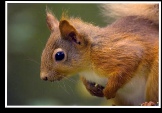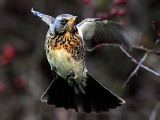




Crested Tit (Parus cristatus)
This species is typically found in the conifer trees of the Cairngorms of Eastern Scotland (which is where these photographs were taken) it required spending several days in a hide using seed feeders to attract then in. They only stay very briefly and typically their distinct zee zee zee call is heard long before you see them.
They hunt among the top branches for insects and spiders occasionally coming lower, mixed bird seed feeds will attract them. They nest in the holes in trees laying 6 -
Marsh Tit (Parus palustris)
A secretive woodland bird eating insects, spiders fruit and seeds. In the autumn it will join flocks of other birds such as blue tits. A hide is too static, we have walked around woodland until we found where the bird was located, with the camera on the mono pod you can then stay until you have some pictures.
Great Tit (Parus major)
The largest of the tit family, this is a frequent bird to garden feeders. It feeds on insects seeds and nuts. It has very bright patches that are easy to over expose in bright light. A soft even light is better for these birds than harsh high contrast sunlight. It nests in holes in trees and will use nest boxes.
Long Tailed Tit (Aegithalos caudatus)
This bird has a tiny body and a very long tail. They travel in flocks their beautiful domed nests are built of moss and lichen. They often feed on garden feeders especially fat balls. Use a fast shutter speed and an aperture of at least F11 to get a good depth of field. The photographs here were taken at F5.6 and depth of field is too shallow, this was due to lighting and ISO restrictions in the Nikon D2xs. Look for new photographs taken later in 2011 where the D3s can use a high iso enabling smaller apertures for better depth of field.
Blue Tit (Parus caeruleus)
The most common of the Tit family , it feeds on seeds nuts and insects regularly using garden feeders and nesting in nest boxes.
Willow Tit (Parus montanus)
Very similar to the marsh tit, their call is the best way to tell them apart. Their call is ezz ezz ezz the call of the marsh tit tcharr tcharr. We photographed this bird from a hide and spent several days trying to get good close shots, especially as they move around very quickly.
Coal Tit (Parus ater)
Conifer wood are the usual home for this small bird. In some woodland they can be very tame and allow you very close. The eat insects spiders and seeds.
